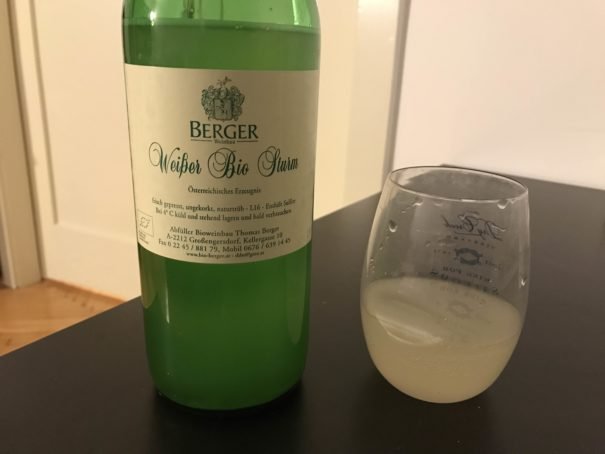
This Might Be One of Those Austrian Things We Don’t Totally Understand

This Might Be One of Those Austrian Things We Don’t Totally Understand
Sturm in Vienna
A lot of Austrian food and drink is still seasonal. In the spring, menus start to fill up with white asparagus the sizes of leeks, and when the weather turns a little warmer, restaurants’ outdoor tables are lined with bright orange Aperol spritzes. In May, strawberries go into tortes, but also make a lethal strawberry punch. The autumn brings Ganslzeit (“goose time”) and the wine season.
The starting gun for the wine season is the presence of large green bottles of Sturm in markets and more traditional restaurants. It’s slightly fermented and unfiltered grape juice, suspended in the state before it becomes wine. Because it’s still fermenting, it’s sold in open bottles; usually there’s just a loose paper lid. You have to drink it pretty quickly. It’s only available for a few weeks, beginning in October. It can be as low as 1 percent ABV, but is often stronger. And Sturm is so rich that Austrians say Mahlzeit—a sort of German “bon appétit”—instead of Prost—the typical cheers when drinking—when they drink it.
Growing up, I spent a lot of time with a friend’s family in a small farming and wine-making community in Austria’s Krems Valley. In the fall, we would help a local wine producer pick the grapes on their wine terraces. In the evenings, when the parents got into the wine, we would often explore the wine cellar and play hide and seek. This was not a basement-sized room where a family might keep a few bottles: it was a vast, subterranean labyrinth, several hundred years old, a musty monument to a community’s livelihood for generations. There were endless rows of car-sized wine barrels and spooky, ink-black corners. (None of us would have dared to spend time in there alone.) I remember the smell the most; damp stone, earth, and the lingering sourness of centuries of wine.
This year I was back in Vienna for Sturm season for the first time in several years, and I bought a bottle from my local deli in a fit of nostalgia. The pungent, damp smell when I lifted off the paper covering took me instantly back to those fall evenings playing hide and seek in a spooky wine cellar. But the flavor didn’t match its aroma at all. It was sickly sweet, like a cloudy grape soda. But with the next glass, it had already lost some sweetness, and tasted a little more like wine.